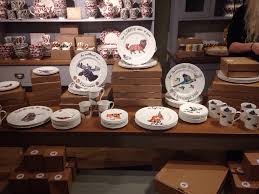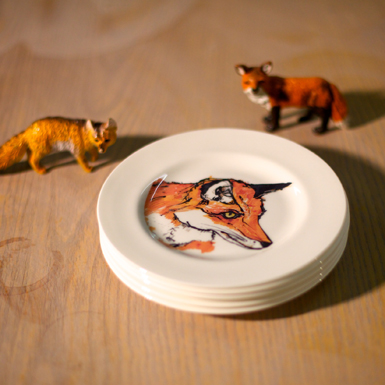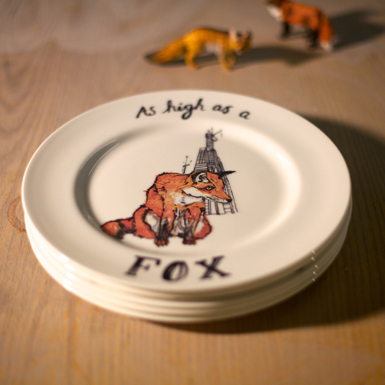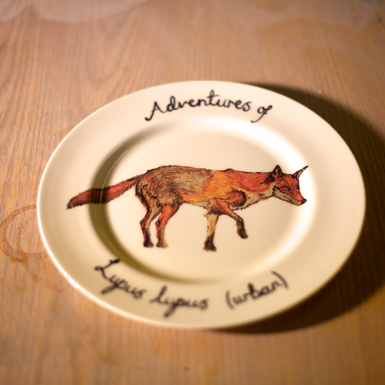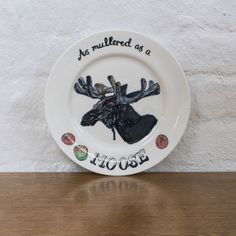SkandiHus Featured on Aucoot
Nordic Bakery's Summer Brand
Interview with Stine for Unconventional Me
On Happiness and My Journey
I have less money than I ever did. I also feel more fulfilled than I ever did. Am I happier? Truth be told, I think so but I don't know. Let me explain.
First of all, it depends on how we define happiness.
The motivational couch, Jay Shetty, said in a recent video for The Huffington Post: "We need to redefine what success means. Let's not make happiness and success about the size of our homes but about the size of our heart. Let's not make it about gratification but gratitude [...] Instead of thinking of what you want to do, think about what you want to be".
I get a lot of emails and approaches from strangers and acquaintances who have heard about my journey from being a lawyer to a potter. They want to know what the secret is to do what I've done. I wish I could give them answers, which is what has lead me to write this blog post. So many people tell me how they dream of quitting their jobs too because they're unhappy. So many people tell me that they wish they had the courage to pursue their dreams. I think they may be getting it the wrong way around.
I didn't quit because I wanted to pursue the next career that was going to fix the emptiness that I felt inside. I quit because I was unhappy in my job and knew I didn't want to do it forever. You get one shot at life and I didn't want to waste mine doing something that didn't fulfil me. However, I didn't quit with a feeling that I'd then be on a path to instant happiness that would come from something external. It might sound the same but there's an important distinction. I didn't know it at the time, but what I was doing was to look around me at the things that made me happy. My (then) partner did, my dog did and my evening pottery classes did. So I quit to have more time for a while for those things that gave me a sense of meaning and fulfilment. I'd saved up enough that I didn't have to work for a year and I had the financial support of my partner, which helped take off the pressure and it gave me a safety net. I didn't know that I'd be able to make a living from my ceramics - nor did I know that my partner would leave me shortly after. And that's the thing, you never really know what's going to happen - it's not in your power to control these things - but what is in your power, is to step off the grind of everyday life, pause and make a decision to focus more on yourself and the things that give you a sense of happiness and purpose. Whether that's going part time, quitting completely, taking a sabbatical or just signing up for evening classes. I think the key is to not do these things thinking that it will be a quick fix solution leading to happiness. Happiness doesn't work like that. Firstly it comes and goes. Secondly, it comes from within and it's often right there in front of us. We're just too busy with life - and with striving for the next thing - to notice. Being stressed and busy is a choice, just as deciding to slow down is.
When people are asked about their biggest regrets their answers often include the word "not". For example, "not saying I love you", "not pursuing my acting career", "not spending enough time with my children"... Again, I didn't realise it at the time but what I did when quitting was to clean the slate of all the "nots" and allow myself to turn them into "dos" - if I wanted to. Anything was suddenly possible. I wanted to go travelling. So I did. I wanted to spend more time making ceramics. So I did. I suddenly found that I was spending a lot of time reflecting on what kind of person I wanted to be and not on what I wanted to be which had otherwise been my focus from an early age (spurred on by careers advisors, societal expectations etc).
I knew I felt a sense of happiness when making. That's all I knew. I've since come across the ideologies behind "mindfulness". It was like someone else had put words to what I intuitively felt and knew to be a better approach to life. When I was making, I was there in the moment, "staying" with what I was doing and, probably for the first time, I stopped running away from things and I stopped looking for the next fix that would fill the emptiness that I was feeling inside. I slowed down and started noticing all the little things in my life that gave me a sense of meaning and fulfilment: a smile from a passerby, the sun warming my face on the bus, a hug from a friend at the studio, a stranger picking up the papers I dropped in a shop - all the little miracles of life and the kindness in the world that so many of us are too busy to notice because we are living in a society that has become obsessed with success, happiness, beauty, achievements and instant gratification.
I still have days when I don't manage to focus on the kindness around me and I feel stressed and overwhelmed. I then try to remind myself of the important fact mentioned above: being busy and stressed is a choice just as slowing down is.
So for what it's worth, there is my answer to "how I did it". I chose to slow down and look for the happiness from inside of myself. I hope you'll find a way to do it too. I promise that it's worth it.
X Stine
Interview with Stine on the Potters Cast
Designer Insights with Stine Dulong
Read Stine's top design tips
The Art of Giving Away
This blog post is about the ceramic artist Lawrence Epps who has become known for giving away his work. There is something about this that appeals to me - for better or worse!
As an artist, Epps explores the collective attribution of value to objects, processes and people. I came across Lawrence’s work first hand at the British Ceramics Biennial (“BCB) in 20013 and again at the BCB in 2015. Both times, his work made me pause and reflect.
His piece for the BCB in 2013 was called Take Stock and it invited people to take one of 12,000 pieces away with them. The piece was a large scale sculpture of tiny extruded office workers sitting at their desks within small confined boxes.
I think that this particular piece made such a big impression on me at the time, as I was in the process of quitting my lawyer job in the city of London to pursue my ceramic career. Epps himself says that the installation was all about questioning the ideologies implicit in the culture of the office and the system, which dictates the shape of our working lives.
The installation was filmed during the duration of the show but the film is only ever now played in reverse – so that it appears as though the audience members are building the troubling stack from the ground up, recreating an office building full of workers trapped inside their ceramic cubicles, stuck in front of their computers.
Epps has explained in an interview that he was intrigued by the way the nature of a visitor’s gaze would change once they discovered they could remove a piece of the sculpture. Suddenly a leisurely but distanced art appreciation of the sculpture as a whole turned into a much more detailed, acquisitive gaze that came with the pressure of choice. I felt this when I was there. I actually didn't want to have to choose - or even take one of the pieces away. But I did. With a strange sense of shame.
At the BCB in 2015, Epps made thousands of porcelain and terracotta coins. Each visitor could take a coin and decide whether to gamble it in a coin pusher machine to try and win more coins or keep the one coin, which they were given. The artist said that the thinking behind the idea for the piece was about people’s desire to acquire accompanied by the constant pressure to disregard what we already have in a bid to get something more.
I love the way that Epps manages to evoke quite basic human emotions in his audiences through his work - and often emotions that we may not be very proud of (greed, inability to choose, questioning our existence, the desire to own objects etc.).
I'm proud to say that I didn't gamble my coin but then again, maybe it was just the desire to own it that stopped me from sticking it in the coin pusher. I guess no one will ever know my reasons for keeping it and maybe that's just as well...
Bye for now.
Love x Stine
Objects of Fired Clays
The dictionary definition of pottery is simply “objects of fired clays”. I am really interested in the relationship between pots and their function – and that’s exactly what this blog post is about.
My ceramics mentor (and hero!), Robert Cooper, recently talked to me about the history of pottery and how firing temperatures in different countries were determined by practical considerations. For example, in African countries, they would fire to lower temperatures because it would keep the clay porous, allowing the water to seep into the clay, thereby keeping the water cold. In Scandinavian countries, however, they fired to higher temperatures as the cold weather meant that the water would freeze and if allowed into the clay, could cause the vessels to break.
Tribal African Vessel
Then there’s the story of the ceramicist who made a coffee cup for her busy journalist and writer friend, who struggled to take breaks when he was working. The ceramicist’s answer was to design a cup, which could not stand up on its own. This forced the writer to get his hands off the keyboard, lean back and enjoy a coffee break. Genius.
Personally, I have recently been commissioned to make coffee cups for a company called the Slow Brew Club. The ethos is all about taking time in your busy day to have a break or as they put it: “Even the best minds need to pause”.
An example of other coffee cups which I have designed
This has made me think about how the design of a cup can alter the drinking experience of the user. With this in mind, I have been working with them to produce a cup that enhances the feeling of pausing without distracting the user both in respect of the shape, colour and texture of the vessel. We are not quite there yet but watch this space for the finished product.
Bye for now
X SkandiHus
The Power of the Story Cont...
The next ceramic artist whom I want to invite into my “hus” (as you know, that’s “house” in Danish) because their story made an impression on me, is the young talented artist Katie Spragg.

Katie graduated from BA (Hons) Wood, Metal, Ceramics and Plastics at Brighton University in 2010. I met Katie when attending a course in print making techniques at Camden Arts Centre where she was sharing her knowledge – and her stories of the curious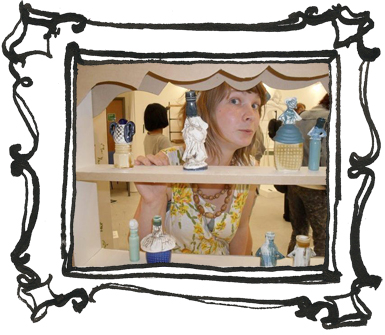 and the bizarre.
and the bizarre.
Inspired by stories in the Metro newspaper, Katie produced a series of plates, which depicted the tales of the bizarre behaviour of urban wildlife.
For example, and one of my favourites, there was the story of the fox, which was found on the 72nd floor of the UK’s highest skyscraper and apparently was surviving off scraps of food left by construction workers.
Or the drunk Swedish (how typical...) moose stuck up a tree that had to be cut free after snaffling too many apples...
Katie has transferred her drawings onto digital transfers which she then adds to the plates. I personally enjoy the expressive and humorous nature of her drawing style which really goes well with these bizarre urban animal stories.
Katie, SkandiHus salutes you!















